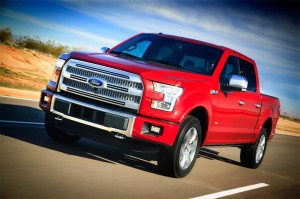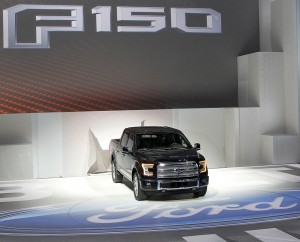
Ford needs to make customers feel comfortable with the new aluminum-intensive design of the 2015 F-150.
Few new models have drawn more headlines lately, and there have been long lines to view the new Ford F-150 at the North American International Auto Show, where the 2015 pickup made its debut last week.
The question is whether the new full-size truck will be the year’s big success story or one of the auto industry’s historic failures. The 2015 F-150 shifts from a traditional steel body to one made of lightweight aluminum, a move that is expected to yield significant improvements in fuel economy. But the new approach has some potential serious risks, industry observers caution, that could cut into Ford’s traditional lead in a market segment that generated close to 2 million sales last year.
While Ford is expected to promote the savings on fuel the new F-150 should yield, the automaker’s marketing manager, Doug Scott, also concedes that truck buyers tend to track costs much more closely than most other vehicle buyers. And one of the key questions is whether the use of aluminum will result in higher long-term operating costs, most notably in terms of durability, reliability and all but inevitable repairs.

Ford's new F-150 will be up to 700 pounds lighter than the outgoing pickup truck. Photo credit: Len Katz.
“For fleet buyers who experience a lot of damage in heavy use, this could be a matter of concern,” said Dave Sullivan, senior auto analyst at AutoPacific, Inc., who says Ford is taking a big risk with the 2015 F-150. “If they can’t pull it off they don’t have a back-up plan. This is like putting all your chips on the table – along with your first-born.”
Ford’s sprawling booth at the Detroit Auto Show is centered around the new F-150, and a sign above the new full-size truck is set to counter what could be a dangerous misconception. “The Future of Tough,” it declares, hoping to offset images of fragile aluminum beer cans that can be crushed in one’s hands.
(For more on the 2015 Ford F-150, Click Here.)
While cans and aluminum foil may be light and flexible, the metal used in vehicle construction is anything but flimsy. In fact, Ford uses similar alloys to those in the U.S. military’s M2 Bradley Infantry Fighting Vehicle. And if anything, contends Pete Reyes, the F-150’s chief engineer, “The dent and ding resistance is better than that of the F-Series today.”
Ford actually has significant real-world experience to back that up, he adds. Prior to launching the new truck, the maker quietly tested an aluminum bed with some of its biggest and most demanding customers, garnering strongly positive feedback.
But the reality is that sooner or later, many of these work trucks will take a ding – or something worse. And that’s where the biggest challenge for Ford comes in. There are tens of thousands of dealers and repair shops across the country familiar and comfortable working with steel. Aluminum is a different matter. The metal is significantly more challenging to work with, notes Bob Emmett, manager of the Autometric Collision Shop in Royal Oak, Michigan, one of the largest independent chains in the Motor City. “Repairing aluminum is much different from steel,” he explains. “It’s more brittle and doesn’t bend the same way,” which is why only one of Autometric’s nine shops is currently certified to work with the metal – and only with some manufacturers’ vehicles.
Ford truck marketing chief Scott acknowledges this is an issue but says the maker is rapidly trying to bring not only its own dealers but major independent service shops across the country up to speed so an F-150 owner won’t have to worry about repairs.
What remains to be seen, of course, is how the price of those repairs will compare to those on the old, steel-bodied F-150. A significant increase could more than offset the fuel savings of the new truck.
The other big issue yet to be resolved is just how well Ford will be able to launch the new, aluminum F-150. The maker plans a cautious phase-in of the 2015 truck while still producing some of the old models. That could buy time if it runs into any snags.
“Ford is going to manage this launch extremely cautiously,” says Stephanie Brinley, analyst with consulting firm IHS Automotive.
(Chevrolet Silverado named North American Truck of the Year. Click Here for more.)
Potential toughness and lower fuel bills are just two of the advantages Ford plans to highlight when it begins to roll out the new truck. By reducing the weight of various F-150 models by as much as 700 pounds it expects to also be able to increase both payload and towing capacity, two key selling points that competitors will now have to address.
Mark Reuss, the new global product development chief at General Motors, says he is “looking forward” to checking out the new Ford truck. But Reid Bigland, president of Chrysler’s Ram brand, which competes with the F-150 with its own Ram 1500 model, insists he’s not worried.
“Our customers believe steel is more durable than aluminum. We also believe steel is the best choice for our customers,” Bigland insists.
Whether Ford can overcome such perceptions could be the biggest challenge the new F-150 faces.
(Click Here to learn how Nissan wants to crowdsource the replacement for its Titan full-size pickup.)

I can see the special editions now…Budweiser Clydesdale…Coors Rocky Mountain…to assuage any misgivings in its manliness!
If Ford has done their homework the aluminum models should not be a failure. Only time will tell if they are durable, corrosion resistant, etc. Lighter weight in general is a good thing as long as the strength has not been compromised. Crash repairs however are going to be higher and that will likely mean increased insurance rates for consumers.
I’ve wondered about this all along. Aluminum requires training, dedicated equipment, different repair techniques. Is a shop going to buy an aluminum welding setup if it’s only for F150s? Until there’s enough of them in operation, it doesn’t make sense.
The luxury cars that have aluminum body panels have been very restrictive about who can repair them, even who can buy parts for them.
I wonder if Ford has worked with State Farm (they drive a lot of the insurance industry’s policies) to figure out how insurance rates will be affected.